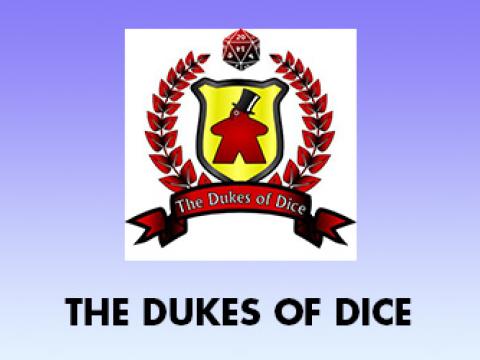
This is Dice Tower Now for the week of January 3, 2022. This week, rumors rise around wood and brass, WizKids holds its breath and solos an SAT word, and Cooper Island gets skilled labor.
TOP STORIES (2:10)
- Cooper Island gets a mini-expansion
- Designer Gavan Brown comments on sequel to Brass
- Woodcraft by Ross Arnold and Vladimír Suchý teased from Delicious Games
- Ticket to Ride Play Pink project raised $184,000
- WizKids announces solo campaign roll and write Bargain Basement Bathysphere
- PSI makes distribution deal with CMoN for Asia and the Middle East
- Cascadia and Lost Ruins of Arnak win Gouden Ludo Flemish Game Award
- Framework coming from Uwe Rosenberg and Pegasus Spiele
- FYFE announced from Pegasus Spiele and designer Kosch
- Solo campaign expansion for Empires of the North coming from Portal Games
CROWDFUNDING (9:10)
- Call of Kilforth by designer Tristan Hall
- The Big Shuffle from Previously Pluto and designers James Ellerby, Evan Hitchings, and Kenneth Oum
- Space Time from Quirky Co and designer Joshua Mason
- The Book of Lost Things from Jay Scott Nolte
SPONSOR UPDATE (15:15)
- Tranquility for the New Year
THE HOTNESS (16:35)
- Ark Nova from Feuerland Spiele and Capstone Games
- Lost Ruins of Arnak by CGE
- Townsfolk Tussle by Stephen Louis, Tony Mayer, and Rachel Rusk
- Dune: Imperium by Dire Wolf Digital
- Sleeping Gods from Red Raven Games
- Wingspan by Elizabeth Hargrave and Stonemaier Games
- Radlands from Roxley Games and designer Daniel Piechnick
- Cascadia from Flatout Games and designer Randy Flynn
CONNECT:
Follow our Twitter newsfeed: twitter.com/dicetowernow
Dig in with Corey at DiceTowerDish.com.
Have a look-see at Barry’s wares at BrightBearLaser.com.

This is Dice Tower Now for the week of January 3, 2022. This week, rumors rise around wood and brass, WizKids holds its breath and solos an SAT word, and Cooper Island gets skilled labor.
TOP STORIES (2:10)
- Cooper Island gets a mini-expansion
- Designer Gavan Brown comments on sequel to Brass
- Woodcraft by Ross Arnold and Vladimír Suchý teased from Delicious Games
- Ticket to Ride Play Pink project raised $184,000
- WizKids announces solo campaign roll and write Bargain Basement Bathysphere
- PSI makes distribution deal with CMoN for Asia and the Middle East
- Cascadia and Lost Ruins of Arnak win Gouden Ludo Flemish Game Award
- Framework coming from Uwe Rosenberg and Pegasus Spiele
- FYFE announced from Pegasus Spiele and designer Kosch
- Solo campaign expansion for Empires of the North coming from Portal Games
CROWDFUNDING (9:10)
- Call of Kilforth by designer Tristan Hall
- The Big Shuffle from Previously Pluto and designers James Ellerby, Evan Hitchings, and Kenneth Oum
- Space Time from Quirky Co and designer Joshua Mason
- The Book of Lost Things from Jay Scott Nolte
SPONSOR UPDATE (15:15)
- Tranquility for the New Year
THE HOTNESS (16:35)
- Ark Nova from Feuerland Spiele and Capstone Games
- Lost Ruins of Arnak by CGE
- Townsfolk Tussle by Stephen Louis, Tony Mayer, and Rachel Rusk
- Dune: Imperium by Dire Wolf Digital
- Sleeping Gods from Red Raven Games
- Wingspan by Elizabeth Hargrave and Stonemaier Games
- Radlands from Roxley Games and designer Daniel Piechnick
- Cascadia from Flatout Games and designer Randy Flynn
CONNECT:
Follow our Twitter newsfeed: twitter.com/dicetowernow
Dig in with Corey at DiceTowerDish.com.
Have a look-see at Barry’s wares at BrightBearLaser.com.

In this episode, Geoff joins Tom and Eric to discuss Witchstone, Picture Perfect, Warp's Edge, Living Forest, Radlands, and Aqua Garden. Geoff leads a live GameTek discussion, Eric and Geoff remember their PAX Unplugged adventures (including discussion of Jurassic World: Legacy of Isla Nublar, Familiar Tales, Corrosion, Scout, and 1923 Cotton Club), and we finish off the show with an overview of the gaming events of 2021.
The Dice Tower is sponsored by TheOp.games and GameNerdz.com.

This week, Star Trek writes about pinball, Star Wars dictates a letter to love, and Asmodee’s boss is no longer the dark horse in the race.
TOP STORIES (2:25)
- Embracer Group purchases Dark Horse Media and Perfect World Entertainment
- Magic the Gathering teams up with Post Malone
- Gil Hova’s The Networks getting a digital version
- Star Trek Super Skill Pinball coming in February
- Star Wars: Jabba’s Palace - A Love Letter Game coming from Z-Man
- Mythic Games partners with Ingenio Games to distribute in Spanish territories
- Mythic announces Rise of the Necromancers expansions
SPONSOR UPDATE (7:50)
- Tranquility and Crime Zoom
CROWDFUNDING (10:05)
- Shikoku: 1889 from Yasutaka Ikeda
- The Palaces of Carrara by Kramer and Kiesling, published by Game Brewer
- designed by Bob and Ryan Craig under One Day West Games
CONNECT:
Follow our Twitter newsfeed: twitter.com/dicetowernow
Dig in with Corey at DiceTowerDish.com.
Have a look-see at Barry’s wares at BrightBearLaser.com.

This week, Star Trek writes about pinball, Star Wars dictates a letter to love, and Asmodee’s boss is no longer the dark horse in the race.
TOP STORIES (2:25)
- Embracer Group purchases Dark Horse Media and Perfect World Entertainment
- Magic the Gathering teams up with Post Malone
- Gil Hova’s The Networks getting a digital version
- Star Trek Super Skill Pinball coming in February
- Star Wars: Jabba’s Palace - A Love Letter Game coming from Z-Man
- Mythic Games partners with Ingenio Games to distribute in Spanish territories
- Mythic announces Rise of the Necromancers expansions
SPONSOR UPDATE (7:50)
- Tranquility and Crime Zoom
CROWDFUNDING (10:05)
- Shikoku: 1889 from Yasutaka Ikeda
- The Palaces of Carrara by Kramer and Kiesling, published by Game Brewer
- designed by Bob and Ryan Craig under One Day West Games
CONNECT:
Follow our Twitter newsfeed: twitter.com/dicetowernow
Dig in with Corey at DiceTowerDish.com.
Have a look-see at Barry’s wares at BrightBearLaser.com.

In this week's episode, Mandi and Suzanne talk about Tammany Hall, LAMA Dice, Bitoku, and Kids Chronicles. Concordia appears in Tap That App. And the Game Pie of the show is full of games from 2016.
The Dice Tower is sponsored by TheOp.games and GameNerdz.com.